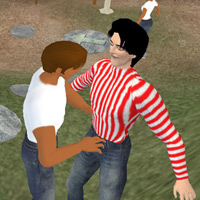- About Us
- Columns
- Letters
- Cartoons
- The Udder Limits
- Archives
- Ezy Reading Archive
- 2024 Cud Archives
- 2023 Cud Archives
- 2022 Cud Archives
- 2021 Cud Archives
- 2020 Cud Archives
- 2015-2019
- 2010-2014
- 2004-2009
 |
No Utopia: |
 For some reason everyone remembers Lawnmower Man despite its premise now appearing hilariously out of date to us future-folk. Stories about virtual worlds seem to be based on what we might find in them –what we humans find lurking there. I remember reading a children’s book in primary school about a VR Tyrannosaurus that ended up materializing in the real world. Even The Matrix, itself comparatively recent, falls into this category: the virtual world we are hooked into bears no relation to the real world.
For some reason everyone remembers Lawnmower Man despite its premise now appearing hilariously out of date to us future-folk. Stories about virtual worlds seem to be based on what we might find in them –what we humans find lurking there. I remember reading a children’s book in primary school about a VR Tyrannosaurus that ended up materializing in the real world. Even The Matrix, itself comparatively recent, falls into this category: the virtual world we are hooked into bears no relation to the real world.
As it turns out we don’t need ludicrous plastic helmets or (thankfully) Keanu Reeves to access our virtual worlds. We live in the age of Massive Multiplayer Online Role Playing (MMORG). And the only menace we find lurking in there is ourselves.
One of the magazines (www.listener.co.nz) I work for ran a column about a disturbing new behavior in Second Life –a MMORG where you can choose a completely new persona, buy property, interact with other players, purchase clothing and test drive Toyota Scions. Apparently some of the players are creating child avatars and then engaging in virtual sex with adult avatars.
 I balked when I read this. As most people know: pretty much the first use mankind found for movie cameras at the beginning of the twentieth century was porn. With each new technological development mankind seems to empty out the full barrel and start scraping the bottom right away. This new trend is much, much darker than those first grainy images of semi-naked women, however. One of the reasons we marketers are so interested in virtual worlds is that they are a direct window into the desires and consumer interests of the players. If a player purchases virtual Addidas shoes it stands to reason they are interested in Addidas as a brand. What about the player that sexually propositions child-like avatars? What can we say about his/her interests and desires?
I balked when I read this. As most people know: pretty much the first use mankind found for movie cameras at the beginning of the twentieth century was porn. With each new technological development mankind seems to empty out the full barrel and start scraping the bottom right away. This new trend is much, much darker than those first grainy images of semi-naked women, however. One of the reasons we marketers are so interested in virtual worlds is that they are a direct window into the desires and consumer interests of the players. If a player purchases virtual Addidas shoes it stands to reason they are interested in Addidas as a brand. What about the player that sexually propositions child-like avatars? What can we say about his/her interests and desires?
Let’s look at a more white-collar example –one that I find fascinating. A player named Dentara Rast in Eve Online, a sci-fi MMORP, set up a fraudulent bank and ripped off other users to the tune of $700 billion Interstellar Kredits, the currency in that virtual world. He used the classic trick of paying out early dividends with money from new accounts until enough people had signed over their loot and he transferred it all to his character. Of course in the real world, that dog just wouldn’t hunt because this trick probably qualifies as the oldest in the book. But it does serve as a startling insight to what people decide to spend their time doing in virtual worlds. Whilst Interstellar Kredits technically have no real value Reuters points out that you can use them to buy game time. So 700 billion ISK can potentially have a real world value of over USD $93 000.
 Back to Second Life, where this week its parent company, Linden Labs, sent a letter to its 650 000 users saying that their customer information –names, addresses, some credit card information- had been compromised and could they all kindly change their passwords. You see why I placed this paragraph right after the last one? In worlds where people elect to commit fraud as a recreational pursuit you probably don’t want companies compromising your personal data.
Back to Second Life, where this week its parent company, Linden Labs, sent a letter to its 650 000 users saying that their customer information –names, addresses, some credit card information- had been compromised and could they all kindly change their passwords. You see why I placed this paragraph right after the last one? In worlds where people elect to commit fraud as a recreational pursuit you probably don’t want companies compromising your personal data.
And so it seems that the real danger lurking in the virtual worlds is us. It’s like the end of a lame Twilight Zone episode. The columnist in the magazine finishes his article by suggesting these people need to “get out more.” I am not so sure. Are we better off having child predators and fraudsters in a virtual world or kicking about in the real world? At the moment their behavior isn’t technically criminal because it is ‘only’ a game, right? It is definitely a tough call. Where’s The Lawnmower Man when you need him?
G Preston White is a New Zealand-based freelance writer. He can be contacted via his website and blog. www.prestonwhite.co.nz
